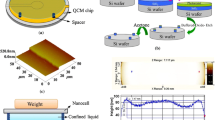Abstract
The rheological properties of the near-surface 5CB (4-pentyl-4′-cyanobiphenyl) liquid crystal (LC) under an external electric field (EEF) are investigated using a dynamic quartz crystal microbalance (QCM). The real-time film-forming process and shearing response of the EEF-induced absorbed LC liquid are studied. The results indicate that the EEF-induced adsorbed LC is composed of a bulk liquid layer and a near-surface boundary layer. Within the boundary layer, the nematic 5CB LC presents an anti-electroviscous effect which may be due to the EEF-induced ordered structure. According to the estimation from QCM measurements, this near-surface layer is about 100 nm thick under certain electric strength and is irreversible even after the EEF is removed. Based on a QCM model, the near-surface LC layer presents a decreased and irreversible viscosity as the EEF voltage increases against the reversible electro-viscous effect of the bulk 5CB liquid crystal measured by rheometer and Raman spectrum measurements. The anti-electroviscous effect of the near-surface 5CB layer is also proved by an improved boundary lubrication property tested on a tribometer. The coefficient of friction of 5CB LC after a preliminary induction of EEF is the lowest one compared to those without EEF and during the application of EEF. The unique anti-electroviscous property of near-surface 5CB LC revealed in this article suggests a potential method to actively reduce shear resistance in boundary lubrication and in microfluidics.







Similar content being viewed by others
References
Carrion FJ, Martinez-Nicolas G, Iglesias P, Sanes J, Bermudez MD (2009) Liquid crystals in tribology. Int J Mol Sci 10(9):4102–4115
Cayer-Barrioz J, Mazuyer D, Tonck A, Yamaguchi E (2009) Frictional rheology of a confined adsorbed polymer layer. Langmuir 25(18):10802–10810
Pasechnik S, Chigrinov V, Shmeliova D (2009) Liquid crystals: viscous and elastic properties in theory and applications. Wiley-VCH Verlag GmbH&Co. KGaA, Weinheim
Clasen C, Kavehpour HP, McKinley GH (2010) Bridging tribology and microrheology of thin films. Appl Rheol 20(4):45049–13
de Gennes P, Prost J (1995) The physics of liquid crystals. Oxford University Press, USA
Drummond C, Israelachvili J (2000) Dynamic behavior of confined branched hydrocarbon lubricant fluids under shear. Macromolecules 33(13):4910–4920
Granick S (1991) Motions and relaxations of confined liquids. Science 253(5026):1374–1379
Horn R, Israelachvili J (1981) Direct measurement of structural forces between two surfaces in a nonpolar liquid. J Chem Phys 75(3):1400–1411
Hu YZ, Wang H, Guo Y, Zheng LQ (1998) Molecular dynamics simulation of ultra-thin lubricating films. Proc IME J J Eng Tribol 212(J3):165–170
Jabbarzadeh A, Harrowell P, Tanner I (2007) The structural origin of the complex rheology in thin dodecane films: three routes to low friction. Tribol Int 40(10–12):1574–1586
Jiang H, Wong PL, Meng Y (2001) Influence of ’off-contact’ electric potential on frictional behaviour of an agate–brass (SiO2–Cu) rubbing couple. Proc IME J J Eng Tribol 215(J2):201–206
Johannsmann D (2008) Viscoelastic, mechanical, and dielectric measurements on complex samples with the quartz crystal microbalance. Phys Chem Chem Phys 10(31):4516–4534
Kubono A, Akiyama R (2006) Viscoelastic analysis in the formation of organic thin films. Mol Cryst Liq Cryst 445:213–222
Kumacheva E, Klein J (1998) Simple liquids confined to molecularly thin layers. II. Shear and frictional behavior of solidified films. J Chem Phys 108(16):7010–7022
Kutnjak Z, Kralj S, Lahajnar G, Zumer S (2003) Calorimetric study of octylcyanobiphenyl liquid crystal confined to a controlled-pore glass. Phys Rev E 68(2):021705
McHale G, Lucklum R, Newton MI, Cowen JA (2000) Influence of viscoelasticity and interfacial slip on acoustic wave sensors. J Appl Phys 88(12):7304–7312
Nakano K (2003) Scaling law on molecular orientation and effective viscosity of liquid-crystalline boundary films. Tribol Lett 14(1):17–24
Negita K (1996) Electrorheological effect in the nematic phase of 4-n-pentyl-4′-cyanobiphenyl. J Chem Phys 105(17):7837–7841
O’Shea SJ, Welland ME, Rayment T (1992) Solvation forces near a graphite surface measured with an atomic force microscope. Appl Phys Lett 60(19):2356–2358
Ruths M, Steinberg S, Israelachvili JN (1996) Effects of confinement and shear on the properties of thin films of thermotropic liquid crystal. Langmuir 12(26):6637–6650
Sheng P (1982) Boundary-layer phase-transition in nematic liquid-crystals. Phys Rev A 26(3):1610–1617
Tsai TR, Chen CY, Pan CL, Pan RP, Zhang XC (2003) Terahertz time-domain spectroscopy studies of the optical constants of the nematic liquid crystal 5CB. Appl Opt 42(13):2372–2376
Wang X, Zhang XJ, Meng YG, Wen SZ (2009) Experimental research on boundary slip of confined liquids at micro/ nano scale and effect of shear rate and viscosity. In: Luo JB, Meng YG, Shao TM et al. (eds) Advanced Tribology. Beijing, pp 542–543
Acknowledgements
The authors would like to thank NSFC for the financial support under grant numbers of 50730007, 50975154, as well as the National Key Basic Research Program of China (Grant No 2007CB607604).
Author information
Authors and Affiliations
Corresponding author
Rights and permissions
About this article
Cite this article
Zhang, X., Zhang, X., Xiong, Y. et al. Anti-electroviscous effect of near-surface 5CB liquid crystal and its boundary lubrication property. Rheol Acta 51, 267–277 (2012). https://doi.org/10.1007/s00397-011-0607-5
Received:
Revised:
Accepted:
Published:
Issue Date:
DOI: https://doi.org/10.1007/s00397-011-0607-5




